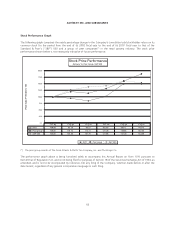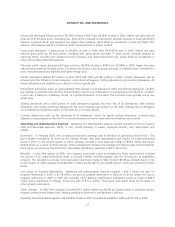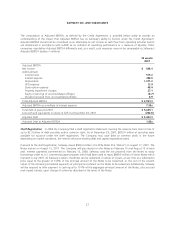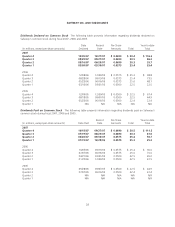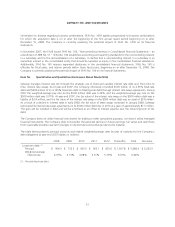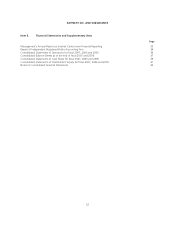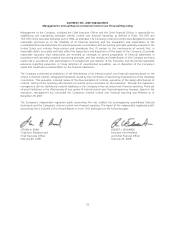Safeway 2007 Annual Report Download - page 46
Download and view the complete annual report
Please find page 46 of the 2007 Safeway annual report below. You can navigate through the pages in the report by either clicking on the pages listed below, or by using the keyword search tool below to find specific information within the annual report.
SAFEWAY INC. AND SUBSIDIARIES
Store Closures Safeway’s policy is to recognize losses relating to the impairment of long-lived assets when expected
net future cash flows are less than the assets’ carrying values. When stores that are under long-term leases close, Safeway
records a liability for the future minimum lease payments and related ancillary costs, net of estimated cost recoveries. In
both cases, fair value is determined by estimating net future cash flows and discounting them using a risk-adjusted rate of
interest. The Company estimates future cash flows based on its experience and knowledge of the market in which the
closed store is located and, when necessary, uses real estate brokers. However, these estimates project future cash flows
several years into the future and are affected by factors such as inflation, real estate markets and economic conditions.
Employee Benefit Plans In September 2006, the FASB issued SFAS No. 158, “Employers’ Accounting for Defined
Benefit Pension and Other Postretirement Plans – an amendment of FASB Statements No. 87, 88, 106, and 132(R).” SFAS
No. 158 requires an employer to recognize in its statement of financial position an asset for a plan’s overfunded status or
a liability for a plan’s underfunded status, measure a plan’s assets and its obligations that determine its funded status as
of the end of the employer’s fiscal year, and recognize changes in the funded status of a defined benefit postretirement
plan in the year in which the changes occur. Additional disclosures are also required. Safeway adopted SFAS No. 158 as
of December 30, 2006, as required.
The determination of Safeway’s obligation and expense for pension benefits is dependent, in part, on the Company’s
selection of certain assumptions used by its actuaries in calculating these amounts. These assumptions are disclosed in
Note I to the consolidated financial statements and include, among other things, the discount rate, the expected long-
term rate of return on plan assets and the rate of compensation increases. Actual results in any given year will often differ
from actuarial assumptions because of economic and other factors. In accordance with GAAP, actual results that differ
from the actuarial assumptions are accumulated and amortized over future periods and, therefore, affect recognized
expense and recorded obligation in such future periods. While Safeway believes its assumptions are appropriate,
significant differences in actual results or significant changes in the Company’s assumptions may materially affect
Safeway’s pension and other postretirement obligations and its future expense.
Safeway bases the discount rate on current investment yields on high quality fixed-income investments. The combined
weighted-average discount rate used to determine 2007 pension expense was 5.9%. A lower discount rate increases the
present value of benefit obligations and increases pension expense. Expected return on pension plan assets is based on
historical experience of the Company’s portfolio and the review of projected returns by asset class on broad, publicly
traded equity and fixed-income indices, as well as target asset allocation. Safeway’s target asset allocation mix is designed
to meet the Company’s long-term pension requirements. For 2007 the Company’s assumed rate of return was 8.5% on
U.S. pension assets and 7.0% on Canadian pension assets. Over the 10-year period ended December 29, 2007, the
average rate of return was approximately 9% for U.S. and 8% for Canadian pension assets.
Sensitivity to changes in the major assumptions for Safeway’s pension plans are as follows (dollars in millions):
United States Canada
Percentage
point
change
Projected benefit
obligation
decrease
(increase)
Expense
decrease
(increase)
Projected benefit
obligation
decrease
(increase)
Expense
decrease
(increase)
Expected return on assets +/-1.0 pt – $ 17.3/(17.3) – $ 3.2/(3.2)
Discount rate +/-1.0 pt $ 96.3/(138.4) $ (8.9)/(9.6) $ 63.0/(75.3) $ 6.3/(8.2)
Cash contributions, primarily in Canada, to the Company’s pension plans are expected to total approximately $35.6
million in 2008 and totaled $33.0 million in 2007, $33.1 million in 2006 and $22.4 million in 2005. Safeway expects to
fund future contributions to the Company’s pension plans with cash flow from operations.
24






